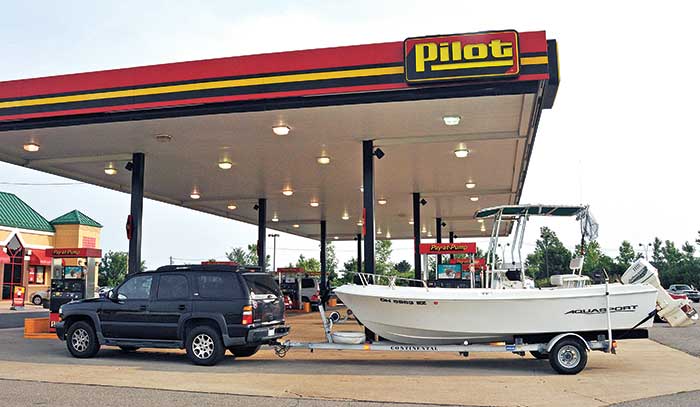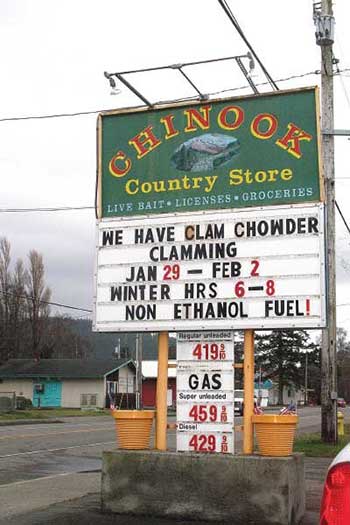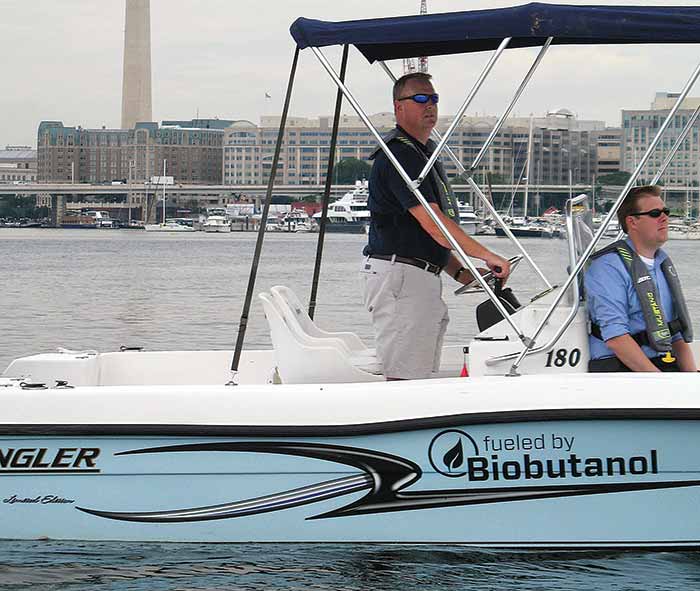Advertisement
Love it or hate it, 10-percent ethanol gas is a fact of life. Ethanol-free can be hard to find, and alarmingly, unless Congress acts soon, even that limited supply could dry up next season.

Photo: Dan Armitage
The tiny port of Chinook, Washington, (pop. 466) tucks into the lee of Cape Disappointment, a few miles from the mouth of the Columbia River and the infamous river bar that makes this one of the country's most dangerous ocean entries. Which is to say, this is about the worst place for any vessel — pocket cruiser or container ship, sport fisherman or commercial trawler — to encounter engine trouble. And that's a very good reason that local boaters and trailering anglers (this is hallowed salmon ground) will opt for better safety by filling up their gasoline-powered inboard, outboard, or sterndrive with ethanol-free fuel when on the river or headed out to sea.

A gas station in Washington advertises non-ethanol fuel to its
fishing clientele. Though many boaters are willing to pay extra
for gas without ethanol in it, the supply may dry up if Congress
fails to act. (Photo: Ryck Lydecker)
Fortunately, the Port of Chinook Marina, as well as the Chinook Country Store, on the main highway not far from the boat-launching ramp, pump "E0," gasoline without the additive ethanol. Ingenious ethanol: The alcohol first blended into gasoline in the 1930s. Innocent ethanol: The well-intentioned green solution to the "nation's energy crisis," brought to us by the U.S. Congress a decade ago. Ubiquitous ethanol: Distilled almost entirely from corn crops, it's now infused in 90 percent of the nation's gasoline supply. Infamous ethanol: Yes, we all know the horror stories, but for the most part, the boating community copes well enough with the current 10-percent blend, called E10, that's available everywhere.
But given the choice, boaters will fuel up with the ethanol-free gasoline in the places where they can find E0, even at an extra 30 cents a gallon, as at the Chinook Country Store. "That's all we run, non-ethanol gas," says Kathy Whiteman, store manager. "People want it for their boats, of course, but also for their weed eaters, four-wheelers, motorcycles. Anything with a small engine." The store is an especially busy gas stop for trailer-boaters during salmon season, Whiteman notes. "We sell a lot of gas then, and the fishermen are really happy that we're here with non-ethanol gas." True, the store has to charge more for E0, Whiteman says, "but customers don't have a problem with that because it's a lot cheaper than fixing their engines."
Whiteman has seen no problems with the supply of E0 locally, and it's likely that few other fuel retailers around the country have, either. But there's still wiggle room between the mandated amount of ethanol and our gas consumption. When refiners face economic penalties for not using the full amount of ethanol as mandated by the federal law, E0 could disappear. It's called the "blend wall," and it's getting closer.
Pile-Up At The Blend Wall
"When Congress wrote what's known as the Renewable Fuel Standard into law in 2005, it assumed that gasoline use in this country would continue to rise as it had been doing for years," reports BoatUS Government Affairs Senior Program Manager David Kennedy. "And the problem with that is, Congress put in ‘Thou shalt use' hard numbers of gallons, not percentages, for the amount of ethanol that must be blended into gasoline by certain target dates," he says. "But given that gasoline usage has actually dropped steadily since then, the law will be forcing more and more ethanol into less and less gasoline. Something's got to give, and that could be the already-limited E0 supply, nationally."
Even five years ago, the federal agency tasked to enforce RFS law, the Environmental Protection Agency (EPA), could see the blend wall looming, Kennedy says, and it chose to accept the ethanol industry's solution: Up the ante to 15 percent. Thus, in 2010, despite the best efforts of BoatUS, its members, and its industry allies, the EPA allowed gasoline containing up to 15-percent ethanol, or E15, to enter the marketplace. The agency did, however, prohibit E15 use in marine engines, in snowmobile and motorcycle engines, and in small engines like those on lawnmowers and leaf blowers as well as in any gasoline-powered car or truck made before 2001.
"Nonetheless, E15 can now be found in 24 states and might even be one of the selections on the same pumps that dispense E10 and even ethanol-free gasoline," Kennedy notes. "We know that many BoatUS members fill up their boats' tanks at roadside gas stations where the higher ethanol blends can be the cheapest fuel at the pump. And that creates a huge potential for misfueling, putting boaters at risk of inadvertently filling up with E15 and damaging their engines."
Only Congress can fix the double whammy wrought by the RFS — the threat of too much ethanol in the fuel boaters can buy and the potential loss of E0. To address this two-sided problem, Kennedy explains, BoatUS is a key member of a broad coalition of organizations, ranging from the American Petroleum Institute to the Environmental Working Group, that's pushing Congress to pass bipartisan bills that could fix the RFS. (See sidebar below.) Included are measures that could stave off potential engine damage from misfueling by limiting E15 production or dropping it altogether. Also on the table is adjusting, by law, the total volume of ethanol that refiners must blend into gasoline in the first place. And that simple change would leave room in the marketplace to supply E0 for boaters and others who want the choice, although in many major metropolitan areas, ethanol-free gas can't be sold due to federal air-quality regulations.
Reform the Renewable Fuel Standard Now!
The Renewable Fuel Standard (RFS) is the regulatory tool that mandates specific amounts of "renewable fuel" or "biofuels" that must be blended into the domestic gasoline supply each year. The economics of fuel production made corn ethanol the cheapest renewable fuel, but it was to be an interim source until new feedstocks such as switch-grass could be developed. In reality, that hasn't happened, and boaters have had to deal with the consequences.
Since ethanol problems began to surface years ago in the form of eroded fiberglass gas tanks, cracking fuel lines, and dissolving seals, BoatUS has battled in Washington to ensure that boaters can buy gasoline that works in their engines. Now, at last, there's hope for the future. At least three bills are moving in Congress to fix the RFS:
- The Corn Ethanol Elimination Act (S. 577). Sponsored by Senators Diane Feinstein (D-CA) and Pat Toomey (R-PA). Amends the federal Clean Air Act by eliminating its corn ethanol mandate, and calls for removing the corn ethanol mandate from the RFS.
- The Renewable Fuel Standard Reform Act (H.R. 704). Introduced by Rep. Bob Goodlatte (R-VA) and co-sponsored by 56 bipartisan members of the House, it would eliminate the corn-based ethanol requirements and cap gasoline's ethanol content at 10-percent. It also requires EPA to set biofuel mandates that match actual demand.
- The Renewable Fuel Standard Elimination Act (H.R. 703). Also sponsored by Rep. Goodlatte, it would eliminate the standard and end all fuel-blending requirements.
- "Renewable fuels are an important component of our nation's energy future," says Former BoatUS President Margaret Podlich. "But boaters should have the choice to buy gasoline, with or without ethanol, that won't damage their engines and put their families at risk with a breakdown at sea. It's up to Congress to give us that choice, and now boaters need to help BoatUS deliver that message to Capitol Hill." Go to the BoatUS Government Affairs website to ask your members of Congress to support any or all of these measures.
"Even if the fuel industry produced only E10, it would be nearly impossible to meet the law's 36-billion-gallon ethanol mandate by 2022," Kennedy notes. "People are driving less today, and they're doing it in increasingly more fuel-efficient cars. The sales of diesels, hybrids, and even all-electric cars continue to rise, so as a nation, we're just not using enough gasoline to absorb that much ethanol."
To "E" Or Not To "E"?
Under current law, the EPA already has authority to adjust the ethanol volume that it requires gasoline refiners to meet. With the blend wall still looming, as part of its legal rule-making process over this past summer, the EPA proposed a complicated formula for lowering the targets that would cut E0 production a whopping 98.5 percent. From the 9.3 billion gallons of ethanol-free fuel consumed for all uses nationwide in 2014, as proposed, E0 production would drop to a mere 130 million gallons; that's about 1.4 percent of today's supply. The proposed rule change generated 22,000 comments from BoatUS members insisting that the EPA assure an adequate supply of engine-safe fuels for boats. (At press time, the EPA had yet to announce any changes, however.)

American Boat & Yacht Council president John Adey tests an Angler center-console powered by a four-stroke Yamaha 90 running biobutanol, a marine-engine friendly alternative to ethanol-blended gasoline. (Photo: Ryck Lydecker)
"While no agency keeps records of how much E0 recreational boaters use, we know from our own surveys that, by far, the majority of boaters will prefer ethanol-free gas when they can get it," Kennedy reports. "As part of this rule-making, EPA did attempt to calculate boater demand for E0 by assessing fuel-dock sales at marinas. But that misses about 95 percent of actual sales since the tanks on most trailerable boats, not to mention portable gas cans, are often filled at conventional roadside gas stations."
Some areas of the country, however, have no E0 supply or boaters find that getting straight gas can be an inconvenience — not to mention an added stretch on their boating dollars — so many are coping with E10. They have to modify their fuel maintenance habits to depend on it as their regular fuel. But even with proper maintenance precautions, ethanol problems are all to common. In fact, some TowBoatUS captains estimate that 20 percent of their on-water assistance calls are the result of fuel problems. As Capt. Dave Hoblin of TowBoatUS Old Saybrook on Long Island Sound puts it, "Of the towing calls we get during the season that can be traced to ethanol problems, about 25 percent are urgent because the vessel is drifting out to sea or in peril of going hard aground."
That sobering report should get the attention of boaters everywhere, and unless Congress acts soon to change the RFS, gasoline blended with ethanol may be the only choice boaters will have at the fuel pump. And the gas coming out of the hose could even have more ethanol in it than your engine can stand.
